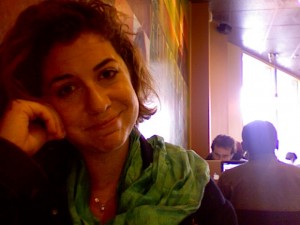One day. Two abstracts. Pray to the guest editors of Learning, Media, & Technology…
SPECIAL ISSUE: Digital Literacy and Informal Learning Environments
Vartabedian, V., Felt, L.J., Literat, I., & Mehta, R. Explore Locally, Excel Digitally: A participatory learning-oriented after-school program for enriching citizenship on- and offline.
KEYWORDS: participatory learning, digital, citizenship, after-school, pedagogy
Following Jenkins and colleagues’ elucidation of participatory culture and new media literacies-enriched education[1], this article argues that facilitating a culture of participatory learning stimulates the development of 21st century social skills and cultural competencies. To support this argument, we examine the components of a new pedagogical framework designed for participatory learning and explore a case study in which this framework was implemented — an after-school program in digital citizenship for Los Angeles public high school students.
A culture of participatory learning (often found in informal learning environments[2]) respects and nurtures: heightened motivation and new forms of engagement through meaningful play and experimentation; learning scenarios relevant to students’ realities and interests; creativity with a variety of media, tools, and practices; a community designed for co-learning; and contexts that are situated within a larger learning eco-system. Such a culture empowers learners to practice new media literacies (NMLs) and social and emotional learning skills (SELs)[3] because it allows for the expression of all voices and multiple ways of knowing.
How one negotiates digital tools and norms impacts citizenship on- and offline. As such, the after-school program “Explore Locally, Excel Digitally” (ELED) used hardware (iPod Touches, desktop computers), software (mobile apps, Twitter, GoogleMaps, Prezi), and team-building activities to investigate ethics, mapping, and their intersections. Students examined the characteristics of their own communities and the nature of their participation within these networks, looking at ELED, their friendship circles, their schools, and the neighborhood surrounding Robert F. Kennedy Community Schools. Using ethnographic fieldnotes, video footage, student-generated multimedia content, and baseline and endline survey measures, we found that this pedagogical framework supported a participatory learning culture in which students practiced NMLs and SELs. Importantly, it also facilitated students’ development of self- and collective efficacy.
[1] (Jenkins, Purushotma, Clinton, Weigel, & Robison, 2006)
[2] Recent studies have established a relationship between out-of-school spaces and learning outcomes (Bell, Lewenstein, Shouse & Feder, 2009), as well as urged schools’ integration of Web 2.0 participation (Schuck & Aubusson, 2010). What facilitates learning in these informal, physical and virtual sites?
[3] (Zins, Weissberg, Wang, & Walberg, 2004)
———————-
SPECIAL ISSUE: City Youth and the Pedagogy of Participatory Media
Felt, L.J. & Rideau, A. Pedagogy for appropriation: How Sunukaddu supports youths’, instructors’, and communities’ development by amplifying voices in Senegal.
KEYWORDS: Dakar, youth, pedagogy, media, voice, sustainability, skills
While the world’s urban population is expected to skyrocket 41% between 1950 and 2050, Senegal’s rate of urbanization has outstripped the average and is projected to ascend even more sharply, growing by 48% over that span[1]. Therefore, as global citizens consider how best to manage youths’ education within the volatile contexts of rapid urbanization, economic uncertainty, public health challenges, and technological shifts, a case study from Senegal can offer potentially useful insights. This article examines Sunukaddu[2], an instructional program in producing civic-oriented multimedia for Dakar youths.
Non-profit organization Réseau Africain d’Education pour la Santé created Sunukaddu in 2008 to support youths’ creation of digital HIV/AIDS messaging[3]. During the summer of 2010, staff redesigned Sunukaddu to facilitate its ease of appropriation. First, they established a collaborative curriculum design process that boosted instructors’ teamwork and ownership. Second, they increased participants’ hands-on exploration and access to local role models. Third, they adopted smartphones and encouraged sharing content online. Fourth, they addressed participants’ communicative capacities by harnessing new media literacies[4] and social and emotional learning skills[5].
Analysis of ethnographic photographs, participant-generated multimedia content, baseline and endline survey measures, participant focus groups, and instructor interviews suggests that Sunukaddu participation supported instructors’ professional development and facilitated youths’ holistic growth. This article argues that Sunukaddu’s design explains its success. Asking instructors and participants to personalize content and raise their voices[6] enriches the learning experience and helps to bridge the “second digital divide”[7] or the “participation gap”[8]. Nurturing fundamental skills[9] prepares individuals for productive negotiation of varied contexts. Finally, leaving open-ended specific activities and technology requirements respects the unpredictability and/or modesty of funding streams as well as the swiftness of social and/or technological change. Thus, Sunukaddu’s adaptable format should ensure its long-term viability — both an important ethical consideration and key development imperative.
[1](WORLD: 1950: 29% urban, 2050: 70% urban; SENEGAL: 1950: 17% urban, 2050: 65% urban; (United Nations Population Division, 2009)
[2](“Our Voice” in the indigenous language of Wolof)
[3](For a review, see Massey, Morawski, Glik, & Rideau, 2009; also Massey, Glik, Prelip, & Rideau, 2011; also Felt & Rideau, in press)
[4](Jenkins, Purushotma, Clinton, Weigel, & Robison, 2006)
[5](Zins, Weissberg, Wang, & Walberg, 2004)
[6]via writing curriculum and producing documentaries, graphic novels, posters, songs, news reports, etc
[7](Somekh, 2007)
[8]which Jenkins et al (2006) define as “the unequal access to the opportunities, experiences, skills, and knowledge that will prepare youth for full participation in the world of tomorrow” (p. 3)
[9]e.g., NMLs and SELs


